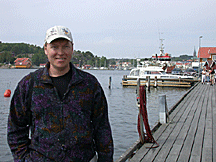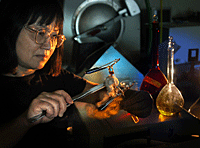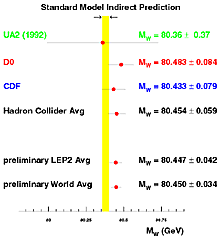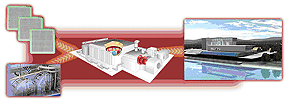| Research
|
|
|||||||||||||||||||||||||
|
HiTEC for better
As the nation accelerates toward revolutionary changes in power production, DOE's Pacific Northwest National Laboratory and the agency's National Energy Technology Laboratory have established a new mechanism—The High Temperature Electrochemistry Center (HiTEC)—to engage university participation in solving key scientific and technical issues. HiTEC is a collaborative research program established in 2002 to make advancements in electrochemistry for next generation energy conversion systems. PNNL and NETL coordinate HiTEC, which includes a research hub at PNNL (including DOE's Environmental Molecular Sciences Laboratory) and the first satellite research center at Montana State University . MSU researchers and their collaborators at PNNL focus on separations technology for advanced power systems—with an emphasis on high temperature applications, carbon dioxide capture and hydrogen separation from coal gas. During HiTEC's first year, PNNL researchers developed new anode materials for solid oxide fuel cells that enable fuel cells to operate at lower temperatures and in environments with higher sulfur contents. MSU researchers identified degradation mechanisms for embedded interfaces within an operating fuel cell, making it possible to extend the lifetime of fuel cells. Plans for the coming year include adding another university satellite center that will focus on a different technology area to widen the breadth of technical barriers being addressed. HiTEC activities align with the President's FutureGen Initiative, as well as with the vision of DOE's Office of Fossil Energy to design and build energy plants that maximize efficiency while minimizing the environmental effects of using fossil fuels. Components of these new plants include fuel cells, turbines and hybrid energy generation systems. Research conducted through HiTEC will be used on the test platform of FutureGen, a $1 billion venture to build a prototype of the world's first fossil fuel power plant that combines electricity and hydrogen production with carbon sequestration technologies for the virtual elimination of harmful emissions, including greenhouse gases. Submitted by DOE's
Pacific Northwest |




